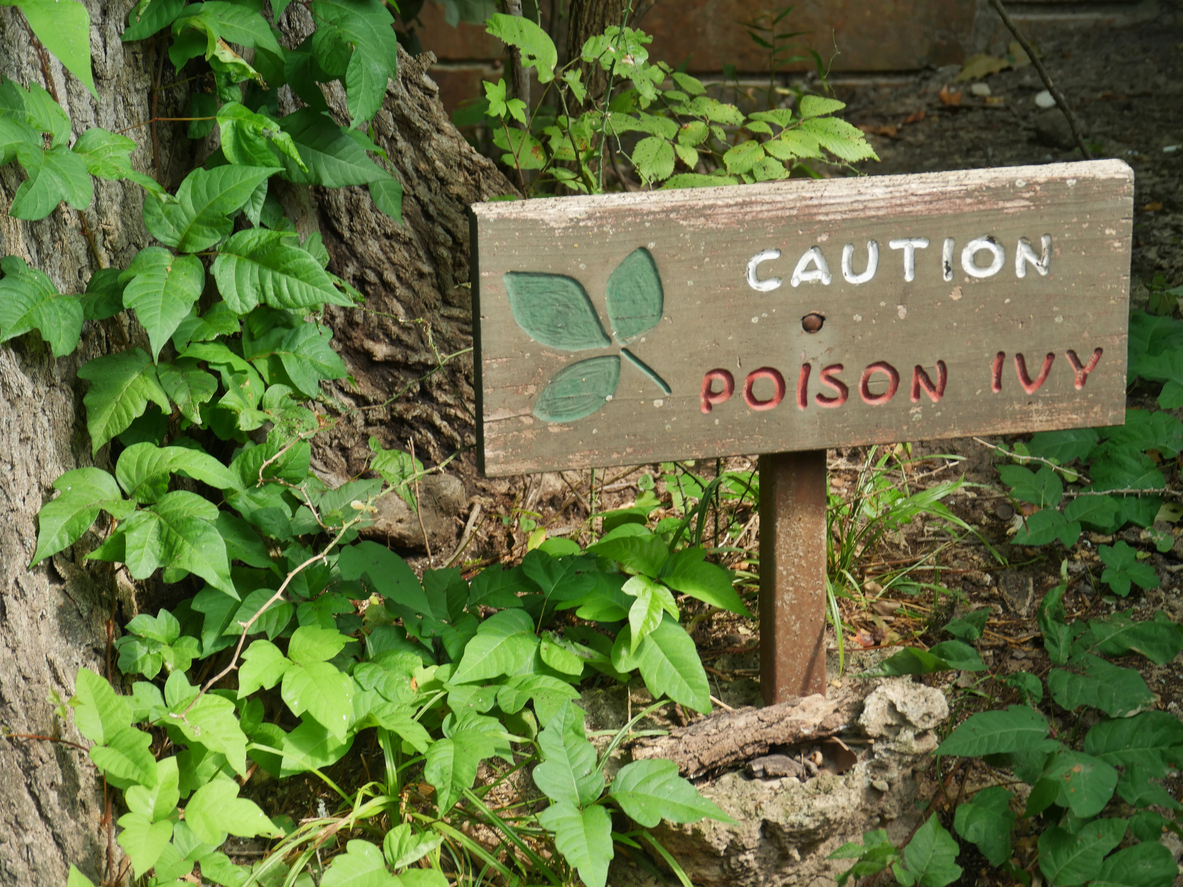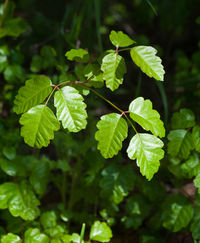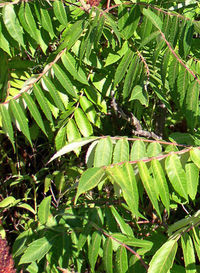
Identifying the Three Poisons: Ivy, Oak and Sumac
These are pesky plants that you and your children should avoid because coming in contact with them can ruin more than just a day or two. If you’re really sensitive to their oils, you can suffer with your reaction to them for weeks.
It’s important for you and your children to be able to recognize these plants, know where they may be growing and how to avoid them. And you should know how to treat the rash that contact with them can cause.
We’re trying to help you take a preventative stance against these pesky plants by providing a quick guide to these plants, including how the three plants differ and where each typically grows.
Spotting the Plants
These three plants have in common that they are made of compound leaves. In other words, multiple leaflets make up one leaf. When you’re trying to identify poison ivy, oak, or sumac, this is an important fact to remember. The difference in them comes down to the number of leaflets you should count on each leaf. Beware of any of this toxic threesome!
Be on the lookout for a dull, waxy sheen on the leaves. The sheen actually comes from urushiol. This is the toxic substance that causes the reaction you may have to the slightest touch of the leaf. This is an oily substance and is found on every part of the plants, including the stems, berries, roots, flowers, and of course, the leaves.
Poison Ivy

“Leaves of three, let it be.” You may have had a grandparent that told you that saying. It isn’t always helpful because many plants have three leaflets but don’t cause quite the reaction that the Poison three plants can cause. It is more accurately “three glossy leaflets with jagged edges that come to a point.” But that just doesn’t roll off your tongue in the same way as grandmother’s saying.
Eastern poison ivy grows as a rope-like vine and can be found all along the East Coast, as well as in the Midwest and some southern and western states. Western poison ivy is a shrub and grows almost everywhere in the continental U.S., excluding California and a handful of southeastern states. Both the east and west versions can produce green or yellow flowers and white to green-yellow or amber berries.
The leaves are usually shiny green but can change to orange-red with hints of yellow in the fall.
Poison Oak

This is another of the three rash-causing pests that fall under the ‘leaves of three’ category. It’s a tricky one to spot because it’s good at camouflaging itself to blend in with the plants around it. The edges of the fuzzy leaflets tend to be more tooth-like than poison ivy and the plant can yield clusters of green-yellow or white berries. The plant also fools you by growing as a low shrub or vine. It also matches the colors of other changing foliage.

Poison oak isn’t as widespread as poison ivy and is usually found along the West Coast (Pacific poison oak) or in the Southeastern states (Atlantic poison oak.)
Poison Sumac
This plant is quite different from its ivy and oak cousins. Poison sumac takes on almost a fern-like appearance and grows between seven and 13 leaflets on a reddish stem. The green leaflets are oval in shape with a pointy top and usually run in pairs up the stem. It is a tall shrub or small tree that flourishes in bogs and swamps. It may have glossy pale-yellow or cream-colored berries and can change colors with the seasons. Poison sumac is found in nearly the entire east coast, parts of the Midwest, and in a handful of southern states. And although poison sumac is partial to bogs and swamps, ivy and oak can wreck havoc just about anywhere—in backyards, parks, fields, wetlands, forests, and along streams and the side of the road.
Hawaii and Alaska are the only two states in the U.S. that don’t grow any of these poisonous plants.
The Rash
These plants have something in common. The rash. You cannot miss it and it’s hardly mistakable for anything else. No kidding. If you had all three types at the same time, you would not be able to tell one rash from the others. And it’s pretty nasty.
The oil is what causes the problems, not the leaf itself, and that oil is common to all three plants. The rash is an itchy, blistery rash.
The rash doesn’t spread from the liquid the blisters produce and it isn’t “contagious” by means of that liquid either. If the oil has been washed from the skin, the rash won’t spread to other parts of the child’s body or to anyone else.
The reason people think the rashes spread is because anything that the oil touches can also cause the rash. Clothing, shoes or gloves worn when the contact with the plant was made may have the oil on them as well and should be thoroughly washed. Pets can even cause the rash if they have come in contact with the plants and then come in contact with you!
Obviously great caution must be taken if the plants are identified in your yard or a park you visit regularly.
Are you wondering how this rash may look on your baby?
Parents.com has a video illustrating: https://www.parents.com/baby/safety/outdoor/the-differences-between-poison-ivy-poison-oak-and-poison-sumac/
Treating the Rash
Small rashes from contact with these plants can be treated at home with wet compresses, cool baths, and calamine lotion, all of which will relieve the itch of the rash. However, you should clean the exposed area with soap and lukewarm water as soon as possible to rid the area of the oil. It’s best to do this within 15 minutes of exposure. If a rash does develop, you’ll typically see it within 24 to 48 hours. Antihistamines can help with itching, but consult your pediatrician about further treatment. If your child is severely allergic to the plants, she can develop life-threatening anaphylaxis that requires immediate medical attention.
Protection from Exposure
Reducing the risk of exposure is a step that you may want to take. You can apply Ivy Block, a topical lotion sold OTC at most drugstores, to your child’s skin, which can provide added protection against poison ivy, oak, and sumac. The key ingredient is bentoquatam and it helps prevent the skin from absorbing urushiol oil. But this cannot be used on children under the age of 6. If younger, you might consider limiting their exposure to this area until the plants are removed or
have them wear long sleeves, gloves and boots.
The best protection is getting rid of the plants. But this, in itself, can be risky.
Getting Rid of the Plants
Some folks think that the best way to get rid of the poison ivy, oak or sumac plants is to burn them. NEVER do this. The smoke from burning the plants is even poisonous and can cause severe allergic respiratory problems if inhaled by you or anyone else that might come in contact with the smoke.
So how do you get rid of the plants? There are a couple of options.
- Simply hire a professional who will come, suited up in protective gear, and pull the plant, shrub or vine up by the roots.
- You can use herbicides that can be used to potentially kill the poison ivy, oak, and sumac plants. There is risk of killing other plants along with the poison ones so you would have to pull the plants away from the ones that you don’t want to harm, if possible. If you leave the roots in tact, the plants are probably going to re-grow.
Reactions to poisons such as urushiol are as unique as the people who may touch the plants that have it. Always contact a physician or pediatrician for your or your child’s unique needs. Always seek the direct advice of your own doctor in connection with any questions or issues you may have regarding your own health or the health of others.
ABOUT LITTLE OTTER
Little Otter Swim School provides quality swim lessons in a safe and fun environment that are taught by caring and enthusiastic teachers. Children are learning and gaining respect and love for the water.
From Little Otter, Charlotte families receive an alternative to “typical” swim lessons in year-round, small group instruction in a warm indoor swimming pool where parents can watch their children’s progress from the comfortable viewing gallery. Little Otter Swim School’s team members are passionate about teaching kids to swim and be safe as they enjoy the water. We’d love to share more of the benefits of learning to swim with you. Learn more about what makes Little Otter different.
Source: Https://www.parents.com/baby/safety/outdoor/the-differences-between-poison-ivy-poison-oak-and-poison-sumac/


Conversations